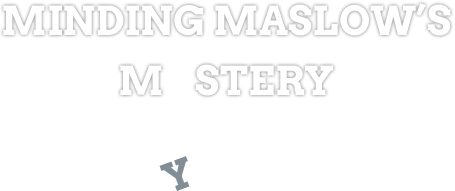The path to a science of human values is better paved by a scientific problem set that’s big enough to demand human values for an answer. Abraham Maslow offered just this range of probletunity with his famous paper on human motivation, commonly recognized as “Maslow’s hierarchy of needs.” We’ve missed his primary problem and its resulting opportunity.
The Maslow quotation shown above is borrowed from his personal journal. He made that entry 20 years and 11 reprints after his theory was first published. Despite a hunch that something must be wrong with our reception to his work, he never did grasp the totality of his miscommunication with the audience.
Maslow’s paper on human motivation is posted here at this website for reference. In closing out that paper his 4th section and 5th item offers a sub-list of 13 issues yet to be worked out in motivation theory. The very first item on that list is “values in motivation theory.”
In missing his problem, we have also stymied his opportunity for forward progress in motivation theory.
Maslow has the principle of prepotency set out in the first part of his paper to organize the hierarchy of needs found in his second part. But then his third part opens with a list of human anomalies, showing key human deviations from the hierarchy of needs. Accordingly, these reflect human exceptions to his principle of prepotency.
The human anomalies to the principle of prepotency show a scientific problem set that may be big enough to demand human values for an answer. That’s what he died believing he had bequeathed to science: its most valuable human challenge. This is why he was bewildered that such a crucial opportunity could be grasped by enough people to make him famous for the effort, and yet no one was trying to work such an important, and, he misbelieved, widely recognized problem.
I think largely due to the fame and acclaim accrued by the paper during his lifetime, Maslow never did realize we were missing the problem posing aspects that held the most crucial significance for him. So, he was never able to coach us to a better understanding.
Volume I of Minding Maslow’s Mystery identifies Maslow’s “proble” so we can begin reaching for the “tunity” in Volume II.
Science has insisted that social science be value neutral like the hard sciences, for example, physics. But Maslow recognized and accepted human values as being central to his human existence and experience. He wanted a social science big enough to recognize, accept, account for, and help administer this primary aspect of being human.
Maslow assumed humans were distinct in nature from the balance of the animal kingdom. He suspected human values somehow held the key to why we don’t comply more fully with prepotency as he understood it. This is partly why his paper contains its swiping mini-rant at the psychology of behaviorism. Maslow’s mini-rant takes the form of an insistence on “human centering rather than animal centering” in motivation theory. He heckled the ridiculousness of studying white rats to learn the motivations of men, dismissing that approach almost presumptively.
One reason he insisted on distinctively human centering in motivation theory is because he believed at least some of our motivation was not animal-common, but human distinctive, in a class all its own.
With a suspicion that our anomalies to prepotency stem from human uniqueness in motivated or motivating values – he went looking for human distinction or uniqueness in motivation theory. He wanted to find what gave us the unique values – and to better understand what those values were, how they worked and so forth. This is what he was looking for when insisting on human centering rather than animal centering in motivation theory.
The Volume II of Minding Maslow’s Mystery recognizes some of the traits Maslow wrestled as not being distinctively human traits in kind. They are only human distinctive in degree, volume, or quantity, but not in quality or nature. The distinctiveness in our animal nature is a distinction in scale and scope of animal-common traits, not uniquely human traits. We have some of our animal common traits to an exponential degree when compared to other animals. So these traits are far more evident to us in us, than they are in the other species. In fact, they are so hyper evident to us in us that we have misunderstood them as uniquely human, and they aren’t. This recognition provides one cornerstone to a trans-species psychology, allowing a beginning recognition of how humans fit within the animal kingdom rather than apart from it.
Maslow assumed we were apart from the animal kingdom in primary ways, with human values as a leading indicator for that range of distinctions. In Part 2 of Minding Maslow’s Mystery I begin making some headway in the direction of human continuity with the animal kingdom rather than human distinction from it.
